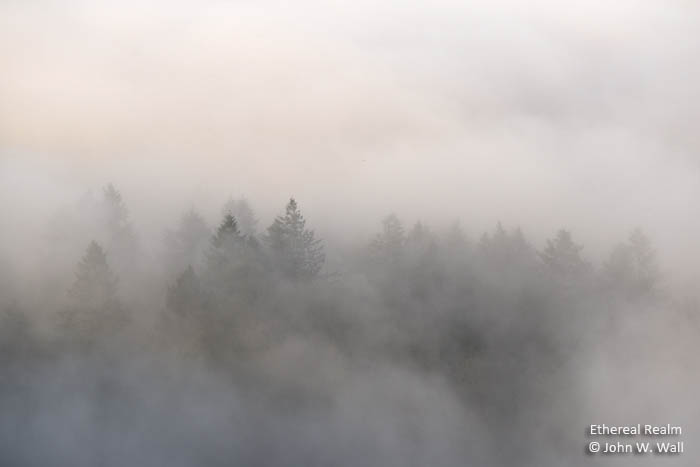* * *
Standing in 80-degree sunshine, looking at 56-degree fog. It was interesting to go back to the pet cemetery this week and find that an animal had dug into the grave somewhat, but stopped before reaching the presumed carcass.
I was running the timelapse at the top of this post when I saw these hikers moving toward a photogenic spot. I let the timelapse go until the last moment before turning it off to grab this shot.
I've always found it important to have 100-percent viewfinder coverage. Using a Nikon F3 for nearly 30 years, I guess I just got used to it. In a scene like this, I'd have been disappointed to have seen this in the viewfinder, only to find in the image that the people or the treetops were cut off.
I saw these blacktailed buck deer feeding on a nearby hillside from a vista point on Bolinas Ridge and walked up the road to photograph them. The angle makes it look like we're on level ground, but I'm actually pointing the camera down a steep hillside.
The trio of bucks seemed fine with my presence at first, but suddenly decided they had business to attend to elsewhere.
The deer had been feeding just on the other side of these guys as they were doing a (presumably) commercial photo shoot featuring their colorful BMW on Pantoll Road.
I took a quick walk down Cataract Creek to look for leopard lilies. I saw some blooming on the south-facing side of the mountain as I drove up to Rock Spring, but they weren't flowering yet along the creek. I know this white-flowered plant is a member of the carrot family, but that's it. I wondered if it was water hemlock (which is even more toxic than poison hemlock), but I'm thinking it's something else. In order to key it out, I'll have to wait until it sets seed. [Update: It's Oenanthe sarmentosa, or water dropwort.]
I didn't recognize this one until I got home and looked it up. I first learned about Prunella vulgaris when I lived in Arcata (where it's a common lawn weed), but I never realized there was a native form of the species that looks quite different. This is the native form.
This is the little marshy area, full of sedge and giant chain ferns, where the leopard lilies are still coming up, but not quite ready to show off.
Another view of the native self-heal.
Not so squat as the introduced form.
On my way home I made one last stop at the vista point where I'd started the day, just to take in the fog which appeared to be creeping higher up the mountain. I caught a slight movement on the hill below and spotted this gray fox just as he spotted me. I reached through an open window on the passenger side of the Jeep and grabbed my camera, sure that the fox would dive into the woods before I could photograph him.
But he was just a little curious about me, and I was able to get a little closer before I finally did step over the line. I sat down in the hope he'd come back out, but I think I dropped out of his mind as soon as he entered the woods. I was able to follow his progress for a while, at first by listening to his footsteps, then by hearing him being scolded by a bunch of scrub jays, and finally by another scolding by a squirrel farther down the hill.
As you can see, I have changed the name of the blog from John Wall's Natural California to the somewhat ponderous A Circumannuation of Mt. Tam. The plan is to spend the next year blogging only about Mt. Tamalpais. The emphasis will mainly be on biodiversity and landscapes, but I'll also show what the humans are up to on occasion. I might even circumambulate the mountain (video), something I feel I ought to do at least once, even though I'm not Buddhist, just to find out if it would deepen my relationship with the mountain.
* * *

























